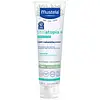What's inside
What's inside
 Key Ingredients
Key Ingredients

 Benefits
Benefits

 Concerns
Concerns

 Ingredients Side-by-side
Ingredients Side-by-side

Water
Skin ConditioningHelianthus Annuus Seed Oil
EmollientGlycerin
HumectantCaprylic/Capric Triglyceride
MaskingButyrospermum Parkii Butter
Skin ConditioningC10-18 Triglycerides
EmollientSucrose Stearate
EmollientHelianthus Annuus Seed Oil Unsaponifiables
EmollientPersea Gratissima Oil
Skin ConditioningAlpha-Glucan Oligosaccharide
CleansingBentonite
AbsorbentGlyceryl Caprylate
EmollientXanthan Gum
EmulsifyingSodium Benzoate
MaskingSodium Stearoyl Glutamate
CleansingCitric Acid
BufferingTocopherol
AntioxidantWater, Helianthus Annuus Seed Oil, Glycerin, Caprylic/Capric Triglyceride, Butyrospermum Parkii Butter, C10-18 Triglycerides, Sucrose Stearate, Helianthus Annuus Seed Oil Unsaponifiables, Persea Gratissima Oil, Alpha-Glucan Oligosaccharide, Bentonite, Glyceryl Caprylate, Xanthan Gum, Sodium Benzoate, Sodium Stearoyl Glutamate, Citric Acid, Tocopherol
Water
Skin ConditioningGlycerin
HumectantPetrolatum
EmollientCaprylic/Capric Triglyceride
MaskingHydrogenated Vegetable Oil
EmollientSucrose Distearate
EmollientDextrin
AbsorbentHelianthus Annuus Seed Oil Unsaponifiables
EmollientPrunus Domestica Seed Extract
Emollient1,2-Hexanediol
Skin ConditioningCandelilla Cera
EmollientSqualane
EmollientSucrose Stearate
EmollientGlyceryl Caprylate
EmollientXanthan Gum
EmulsifyingGlucose
HumectantSorbitol
HumectantPersea Gratissima Fruit Extract
EmollientCeramide NP
Skin ConditioningPhytosphingosine
Skin ConditioningWater, Glycerin, Petrolatum, Caprylic/Capric Triglyceride, Hydrogenated Vegetable Oil, Sucrose Distearate, Dextrin, Helianthus Annuus Seed Oil Unsaponifiables, Prunus Domestica Seed Extract, 1,2-Hexanediol, Candelilla Cera, Squalane, Sucrose Stearate, Glyceryl Caprylate, Xanthan Gum, Glucose, Sorbitol, Persea Gratissima Fruit Extract, Ceramide NP, Phytosphingosine
Ingredients Explained
These ingredients are found in both products.
Ingredients higher up in an ingredient list are typically present in a larger amount.
This ingredient is an emollient, solvent, and texture enhancer. It is considered a skin-softener by helping the skin prevent moisture loss.
It helps thicken a product's formula and makes it easier to spread by dissolving clumping compounds.
Caprylic Triglyceride is made by combining glycerin with coconut oil, forming a clear liquid.
While there is an assumption Caprylic Triglyceride can clog pores due to it being derived from coconut oil, there is no research supporting this.
Learn more about Caprylic/Capric TriglycerideGlycerin is already naturally found in your skin. It helps moisturize and protect your skin.
A study from 2016 found glycerin to be more effective as a humectant than AHAs and hyaluronic acid.
As a humectant, it helps the skin stay hydrated by pulling moisture to your skin. The low molecular weight of glycerin allows it to pull moisture into the deeper layers of your skin.
Hydrated skin improves your skin barrier; Your skin barrier helps protect against irritants and bacteria.
Glycerin has also been found to have antimicrobial and antiviral properties. Due to these properties, glycerin is often used in wound and burn treatments.
In cosmetics, glycerin is usually derived from plants such as soybean or palm. However, it can also be sourced from animals, such as tallow or animal fat.
This ingredient is organic, colorless, odorless, and non-toxic.
Glycerin is the name for this ingredient in American English. British English uses Glycerol/Glycerine.
Learn more about GlycerinGlyceryl Caprylate comes from glycerin and caprylic acid, a fatty acid from coconut. It has emollient and emulsifier properties.
As an emollient, it helps hydrate your skin. Emollients work by creating a barrier on your skin to trap moisture in, helping to keep your skin soft and smooth.
On the other hand, emulsifiers prevent ingredients (such as oil and water) from separating.
Learn more about Glyceryl CaprylateHelianthus Annuus Seed Oil Unsaponifiables is an oil and isn't fungal acne safe.
Sucrose Stearate is derived from stearic acid and sucrose (sugar). It is an emollient and emulsifier.
As an emulsifier, it prevents oils and water from separating in a product. This property also makes it a surfactant and therefore a cleansing agent.
Water. It's the most common cosmetic ingredient of all. You'll usually see it at the top of ingredient lists, meaning that it makes up the largest part of the product.
So why is it so popular? Water most often acts as a solvent - this means that it helps dissolve other ingredients into the formulation.
You'll also recognize water as that liquid we all need to stay alive. If you see this, drink a glass of water. Stay hydrated!
Learn more about WaterXanthan gum is used as a stabilizer and thickener within cosmetic products. It helps give products a sticky, thick feeling - preventing them from being too runny.
On the technical side of things, xanthan gum is a polysaccharide - a combination consisting of multiple sugar molecules bonded together.
Xanthan gum is a pretty common and great ingredient. It is a natural, non-toxic, non-irritating ingredient that is also commonly used in food products.
Learn more about Xanthan Gum